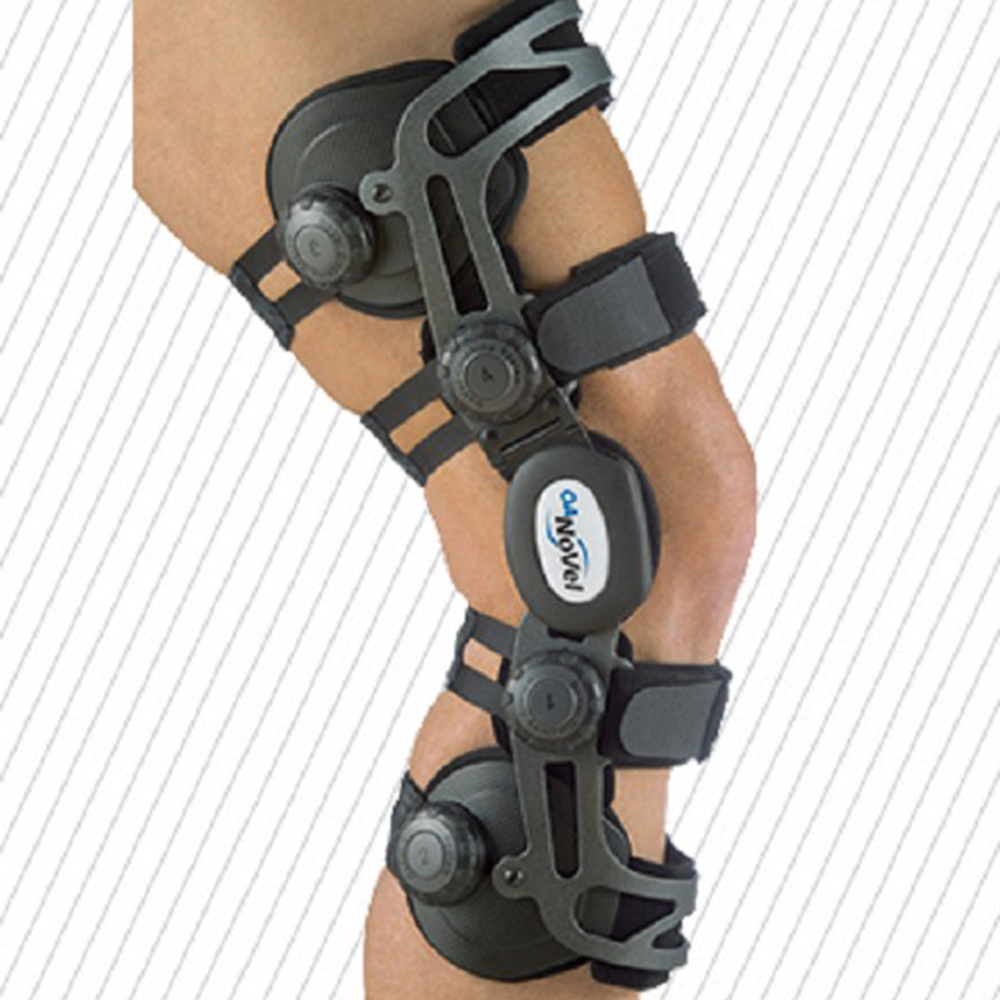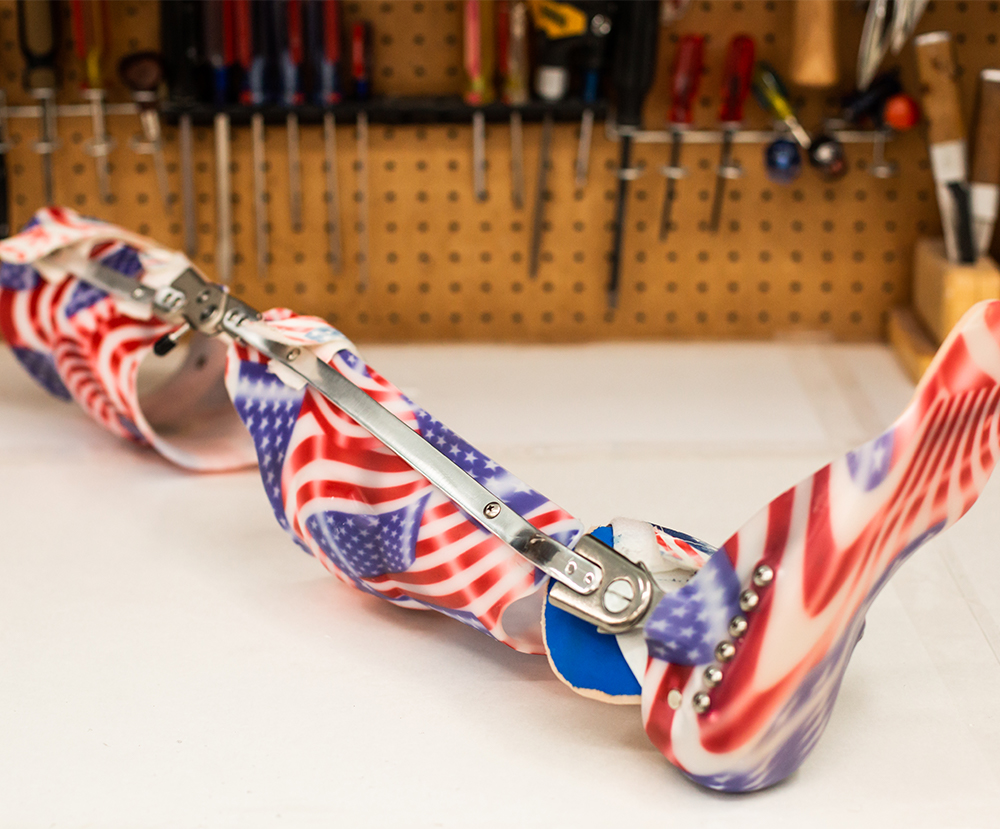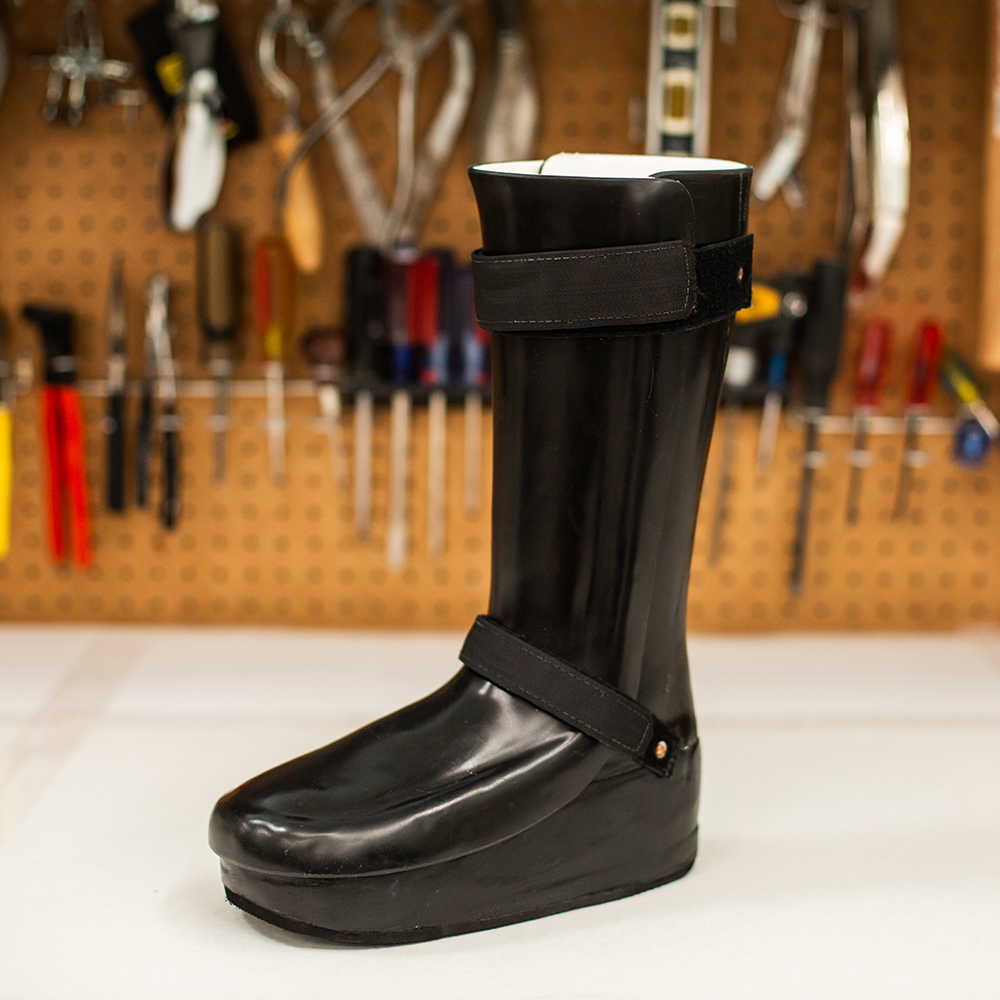Lower Extremity Orthotics
Knee Orthoses (KO)
May be used to treat genu varum, valgum and recurvatum. KOs are used for any knee ligament instability or cartilage damage.
Prophylactic KO prevents or reduces the severity of knee ligament injuries before they occur. Usually a neoprene wrap or sleeve.
Rehabilitation KO allows protected motion of injured knees that have been treated operatively or non-operatively. These braces allow for controlled joint motion and typically consist of hinges that allow motion within the patient’s available range and can be adjusted to allow more motion as the patient progresses.
Osteoarthritic (Unloader) KO. During normal walking, the knee joint is subjected to inward bending, which shifts the joint load to the (medial) compartment. To reduce this load, the orthosis applies a valgus outward bending correction using three-point pressure, which ultimately shifts the load to the lateral compartment of the knee. A variety of orthotic braces are available to help with pain management and ease of movement, including over the counter elastic or neoprene supportive braces, or the unloader brace. The patient benefits from an unloader brace when the osteoarthritis affects only one compartment of the knee, which typically collapses. The unloader brace will unload the weight from the collapsed department, reduce pain, and decrease the need for medication.
Functional KO assists or provides stability for unstable knees. Stabilizing knee braces have medial and lateral bars with varying hinge and strap designs.
Sycamore OA Knee Brace provides dynamic unloading of the medial compartment when the patient needs it most – in the last 30 degrees of extension. As the brace moves into full extension, the Dynamic Unloading Hinge allows the strut on the medial side to lengthen, changing the angle of the brace and effectively unloading the knee. This dynamic unloading system prevents the pain and discomfort often associated with other braces that provide a constant load to the knee joint.

Non-articulated KO
Intended for short-term use because the inability to bend the knee makes it difficult to sit and rise again.
Knee Immobilizer circumferentially encompasses the leg and restricts knee motion in all directions. A custom molded knee cylinder made from high-temperature thermoplastic provided better self-suspension. The long leverage offered by intimate fitting from the ischium to the malleoli, and the self-suspension from contouring in the supracondylar fossa, account for the superior stabilization.
KAFO
Single/Double bar (upright KAFO) accommodates volume fluctuation, cooler than total contact, highest material strength. Lock options for ambulation and sitting. Single bar styles are common in pediatric practice, while stronger double bar configuration is typical for adult applications.
Total Contact (thermoplastic) KAFOs advantages include lower pressures for a given magnitude of biomechanical control, and the thin, tough, flexible nature of the plastic material.
Ischial Weight Bearing (unweighting) with ischial containment or quadrilateral style brims with high trimlines partially unweight the knee, shin, ankle, or foot. Due to the compressibility of the soft tissues, this is often difficult to achieve. Generally used with paralytic limbs.

HKAFO
Reciprocating Gait Orthosis (RGO) – Allows one leg to be placed ahead of another. The patient is braced from mid-trunk to the feet. The hip joints are linked (band, cables, push-pull rod) so that the extension of one hip joint forces flexion in the other. Generally used in pediatrics (spina bifida) but can be used for adult paraplegics, muscular dystrophy, cerebral palsy, and multiple sclerosis.
Ankle Foot Orthoses (AFOs)
We design orthotics for each specific patient using casts, measurement, and working models to ensure maximum comfort and fit. Certified Orthotist Chris Spevok is buffing an AFO made in-house to remove the sharp edges.
Dynamic AFO is a functional, active resistance ankle brace that incorporates a spring-loaded, adjustable tension mechanism that applies continuous dynamic stress in either flexion or extension to aid in resolving ankle joint stiffness or diminished range of motion. It helps in maintaining proper musculoskeletal alignment to prevent deformity and maintain soft tissue extensibility and ROM of the foot and ankle resulting from illness, surgery, joint trauma, or congenital abnormalities.
Ground Reaction AFO is a custom-molded thermoplastic orthosis containing a rigid anterior tibial section, ankle, and footplate designed to provide posteriorly directed forces just below the knee to promote knee extension in stance phase. It is used for patients with neuromuscular disorders resulting in weak quadriceps that exhibit a “crouched” type gait during stance phase.
Solid AFO (SAFO) helps to control the knee by preventing hyperextension and/or hyperflexion. Also prevents foot drop by blocking plantar flexion, dorsiflexion and varus/valgus deviation of the ankle.
Supra Malleolar Orthosis (SMO) is used as an intermediate orthosis when an AFO is considered over bracing and a foot orthosis does not address specific needs of the patient. SMO supports the leg just above the ankle bones. Designed to maintain a vertical or neutral heel while it supports the arches of the foot to improve balance and mobility.
Immobilizing AFO is commonly used with a lower extremity deficiency when ankle immobilization is desired such as with a distal tibia/fibula fracture, foot bone fractures, tendo calcaneus rupture or diabetic (Charcot) foot.
Posterior Leaf Spring controls drop foot, plantar-flexion at heel-strike, dorsiflexion at swing phase. Fabricated from lightweight thermoplastic, the anatomically correct shape will fit inside most lace-up shoes. Orthosis may be custom trimmed and reshaped. Narrow calf shell and narrow ankle trim line behind the malleoli. Compensates for weak ankle dorsiflexors by resisting ankle plantar flexion at heel strike and during swing phase with no mediolateral control.
Richie Brace is a custom ankle brace (ankle foot orthosis) designed to treat chronic conditions of the foot and ankle including Drop foot, PTTD, ankle sprains and other causes of foot and ankle pain. With a contoured balanced orthotic footplate articulated to adjustable semi-rigid lower leg uprights, the Richie Brace is ideally suited to stabilize rotational forces at the midtarsal, subtalar and talo-crural joints. Modifications and enhancements are available to add further restriction of motion in the sagittal, frontal or transverse plane.
Arizona AFO is effective in the management of PTTD. It fits easily into a comfort shoe and stabilizes the ankle area, the talocalcaneal, mid-tarsal and subtalar joints. It provides medial and lateral stability to minimize sinus tarsi impingement and reduces either forefoot abduction or adduction.
Custom AFO is a brace that is custom made to fit your lower leg, ankle and foot. A custom AFO can be fabricated in a variety of styles and many different materials may be used in the fabrication of the device.
PRAFO (Pressure Relief Ankle Foot Orthosis) helps to control dorsi-plantar flexion for patients with compromised mobility and at risk of developing pressure sores at the heel.
Ankle Supports are designed to provide medial-lateral ankle support in stance phase. They come in different styles and materials, from off-the-shelf pneumatic air cast splints to lace-up canvas ankle supports. They are used to correct ankle instability, avulsion fractures, sprains, inversion-eversion control, ligamentous injuries, minor fractures of the foot and ankle, and protection of the ankle and foot during rehabilitation.
Foot Orthoses (FO)
Off-Loading wound shoes are therapeutic shoes designed to provide pressure redistribution for patients at-risk for diabetic foot conditions such as neuropathic ulcers, Charcot foot and infection.
CROW (Charcot Restraint Orthotic Walker) Boots are used for the prevention and management of pressure ulcers caused by ischemia, direct trauma and/or repetitive stress often found in persons with chronic illness, diabetes mellitus, Charcot joints, limited mobility, and decreased sensation and/or paralysis. The orthosis fully encloses the ankle/foot/calf, preventing foot and ankle movement. By distributing pressure equally throughout the leg and foot, the orthosis removes excessive forces and gives the foot time to heal.

CAM (Controlled Ankle Movement) Walker Boots allow walking even with the intensive injuries. There is minimal or no movement for the hinge of the ankle in order to rest/protect the damaged area until the CAM Walker can be removed.
DH Offloading Walker provides shear force reduction by stabilizing foot and ankle at 90º. Offloading insole with removable hexagons. Inner bootie prevents foot from migrating on insole. Wide, low-profile rocker bottom allows a smooth roll-through and increases stability for altered gait. An alternative to total contact casting in treatment of plantar based ulcers. Fits left or right.
ASO (Ankle Stabilizing Orthosis) is for the prevention and treatment of ankle injuries and is especially suited for the athlete. Unlike traditional taping, the ASO has nylon stabilizing straps and a nylon boot and will fit inside any normal street or athletic shoe. The reusable brace can be retightened anytime, even without taking off the shoe.
UCBL is a maximum control foot orthosis that fully encompasses the heel with a molded heel cup, which holds the heel in a neutral vertical position. UCBL devices are custom designed to a height that supports but does not severely limit shoe choice. A UCBL device includes a very deep heel cut, high medial flange, high lateral flange, and extrinsic rearfoot post.